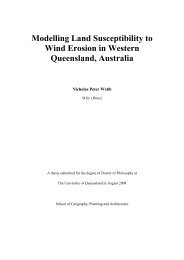Ninti One Limited
Ninti One Limited
Ninti One Limited
You also want an ePaper? Increase the reach of your titles
YUMPU automatically turns print PDFs into web optimized ePapers that Google loves.
<strong>Ninti</strong> <strong>One</strong> <strong>Limited</strong>Submission to the Department of Prime Minister and Cabinet,Office of the Arts on the National Cultural Policy Discussion Paper<strong>Ninti</strong> <strong>One</strong> <strong>Limited</strong>ABN: 28 106 610 833PO Box 3971, Alice Springs, NT, 0871<strong>Ninti</strong> <strong>One</strong> <strong>Limited</strong> Contacts:Jan Ferguson, Managing Director: 0401 719 882; jan.ferguson@nintione.com.au1 | P age
About <strong>Ninti</strong> <strong>One</strong> <strong>Limited</strong><strong>Ninti</strong> <strong>One</strong> Ltd (NOL) was originally established to operate the Desert Knowledge CooperativeResearch Centre (DKCRC), but now operates as an independent company to manage the intellectualproperty from the former Desert Knowledge CRC, manage the current research activities andpartnerships of CRC for Remote Economic Participation (CRC-REP), manage the Australian FeralCamel Management Project(AFCMP) and engage in other activities related to the delivery andcommercialisation of research for the benefit of Australians living in remote areas. Our mission is toprovide the knowledge base essential to create thriving remote communities and economiesthrough research, innovation, expertise, education and outreach. Our network of 50 partners andparticipants spans the Australian continent.Our aim is to:• address social and economic disadvantage of people in remote regions of Australia;• find solutions to economic exclusion;• increase people's economic participation;• improve understanding of Australia’s remote regions;• increase the skills and capacity of their people;• enhance and protect the natural environment; and• understand the impact of climate change on remote Australia.IntroductionOver the past Forty years Aboriginal and Torres Strait Islander art has become a primary symbol ofcontemporary Aboriginal and Torres Strait Islander cultural life and enterprise, and a key currency ofAustralian cultural value. Despite this prominence there is very limited understanding of the scaleand characteristics of the ‘art economy’ and of the relationships that animates much of the activityin this sector.Our submission concentrates on Aboriginal and Torres Strait Islander art, being a key element of thecore business of <strong>Ninti</strong> <strong>One</strong>.Characteristics of the Aboriginal and Torres Strait Islander art sectorThe distinctive circumstances of the creation and consumption of Aboriginal and Torres StraitIslander reflect the complex relationship between Aboriginal and Torres Strait Islander people andmainstream Australia, and profound issues of political, economic and cultural inequality. Thesecomplexities are played out in the creative sector and are characterised by:〉 Fragility: despite the visible successes, there are consistent reports of fragility and a lack ofsustainability within the sector: this fragility has many forms – the age/infirmity of many of theleading artists, the limited capacity of many enterprises that support art and artists, thevagaries of the national and global art market.〉 <strong>Limited</strong> Evidence: despite some exceptions, there remain enormous gaps in knowledge andunderstanding of the fundamentals of the sector, resulting in very limited evidence to informpolicy or industry development. The 2007 Senate Inquiry into the sector highlighted theabsence of even basic statistics such as the number of artists and the value of the sector.2 | P age
〉 Intercultural Zone: Aboriginal and Torres Strait Islander art is created within one culturaluniverse and consumed within another. The exchange at the heart of the industry (objects,ideas, money) unfolds in the space between two very different sets of worldviews.〉 Exclusivity and Market Segments: the art market is motivated by unwritten, but fixed principlesof exclusivity and supply/demand. The concepts at work in the art market often do not translateto remote community life, particularly for the majority of artists who are not ‘stars’.Research by the Cooperative Research Centre for Remote Economic ParticipationIn recognition of the extraordinary place of Aboriginal and Torres Strait Islander art within theAustralian narrative and its complex, poorly understood characteristics, a new long-term researchproject is commencing. Delivered by the Cooperative Research Centre for Remote EconomicParticipation (see: www.crc-rep.com.au) the Aboriginal and Torres Strait Islander Art EconomiesProject will investigate and analyse the Aboriginal and Torres Strait Islander art economy, itsparticipants and their relationships, and its commercial, creative and inter-cultural conditions.This research will identify, understand and, in partnership with stakeholders, seek to address thenumerous types of fragility that affect the sector. The primary focus of this research project is tocontribute to the livelihoods of Aboriginal and Torres Strait Islander artists and ensure artistic andcultural practice remains a viable means of improving wellbeing for individuals and theircommunities and an important commercial and professional opportunity. A further focus of thisproject is to provide evidence and information to commercial, community and government sectors,thereby enabling informed decision making and adding to the overall strength, profile and viabilityof the ‘art economy’.The Art Economies Project will be anchored by economic analysis and modelling of financial datafrom across the industry – the first national assessment of the sector’s financial scope and scale.Aligned to this economic mapping will be important, complementary research into the three primaryzones within the sector’s overall ecology:〉 Artists: what combination of circumstances enables the production of art? What professionaland personal choices are Aboriginal and Torres Strait Islander people making when participatingin the ‘art economy’?〉 Agents: what relationships underpin the exchanges that move art from producers toconsumers? What are the circumstances of, and opportunities for, agents? What improvementscould be made? How can fragility be reduced?〉 Audiences: what motivates and informs consumers? How is the ‘taste’ for Aboriginal and TorresStrait Islander Art created?The CRC-REP Aboriginal and Torres Strait Islander Art Economies Project will be commencingresearch during 2012 and conclude in 2016. Research activity will be concentrated in the first half,while the second half will deliver on the research findings, including training and improving creativeand commercial opportunities for Aboriginal and Torres Strait Island people, and the wider sector.3 | P age
Should you wish to discuss any of the information included in this submission or become involved inthe research being undertaken please do not hesitate to contact:Prof. Tim AckerPrinciple Research LeaderAboriginal and Torres Strait Islander Art Economies ProjectPhone: 0410 038 226Email: tim.acker@nintione.com.auDr. Kevin WilliamsGeneral Manager Research, Evaluation and ImpactPhone: 0409 102 209Email: kevin.williams@nintione.com.au<strong>Ninti</strong> <strong>One</strong> Ltd17 October 20114 | P age
















